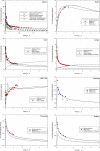A revised compartmental model for biokinetics and dosimetry of 2-[18F]FDG
- PMID: 36752876
- PMCID: PMC9908780
- DOI: 10.1186/s40658-023-00528-9
A revised compartmental model for biokinetics and dosimetry of 2-[18F]FDG
Abstract
Background: The aim was to review available biokinetic data, collect own experimental data, and propose an updated compartmental model for 2-[18F]FDG in the frame of the revision of the ICRP report on dose coefficients for radiopharmaceuticals used in diagnostic nuclear medicine.
Methods: The compartmental model was developed based on published biokinetic data for 2-[18F]FDG. Additional data on urinary excretion in 23 patients (11 males, 12 females) undergoing whole-body PET/CT examinations were obtained within this study. The unknown biokinetic model parameters were derived using the software SAAM II and verified with a modified version of IDAC-Iodide. Dose coefficients for reference adults were calculated with the programme IDAC-Dose 2.1. A dynamic bladder model was employed for urinary bladder dosimetry.
Results: The proposed model consists of following compartments: blood, heart wall, brain, liver, lungs, pancreas, spleen, kidneys, urinary bladder content and a generic pool compartment "Other". The latter was introduced to account for 2-[18F]FDG in body organ and tissues besides the explicitly modelled ones. The model predictions showed a good agreement with experimental data. Urinary bladder wall received the highest absorbed dose coefficient of 7.5E-02 mGy/MBq under the assumption of initial urine volume of 100 ml, first voiding at 45 min p.i. and 3.75 h voiding intervals thereafter. The effective dose coefficient calculated according to the current dosimetry framework of ICRP amounted to 1.7E-02 mSv/MBq, compared to 1.9E-02 mSv/MBq in ICRP Publication 128.
Conclusion: A compartmental model for 2-[18F]FDG was proposed and will be used to replace the descriptive biokinetic model of ICRP Publication 128. The revised model and the provided dose coefficients are expected to improve reference dosimetry for patients administered with 2-[18F]FDG.
Keywords: Absorbed organ dose; Biodistribution; Effective dose; Fluorodeoxyglucose; Nuclear medicine.
© 2023. The Author(s).
Conflict of interest statement
The authors have no relevant financial or non-financial interests to disclose.
Figures



References
-
- ICRP. Radiation dose to patients from radiopharmaceuticals: a compendium of current information related to frequently used substances. ICRP Publication 128. Ann. ICRP 44(2S). 2015. - PubMed
-
- Hays MT, Watson EE, Thomas SR, et al. MIRD dose estimate report no. 19: radiation absorbed dose estimates from 18F-FDG. J Nucl Med. 2002;43:210–214. - PubMed
-
- Hays MT, Segall GM. A mathematical model for the distribution of fluorodeoxyglucose in humans. J Nucl Med. 1999;40:1358–1366. - PubMed
LinkOut - more resources
Full Text Sources

